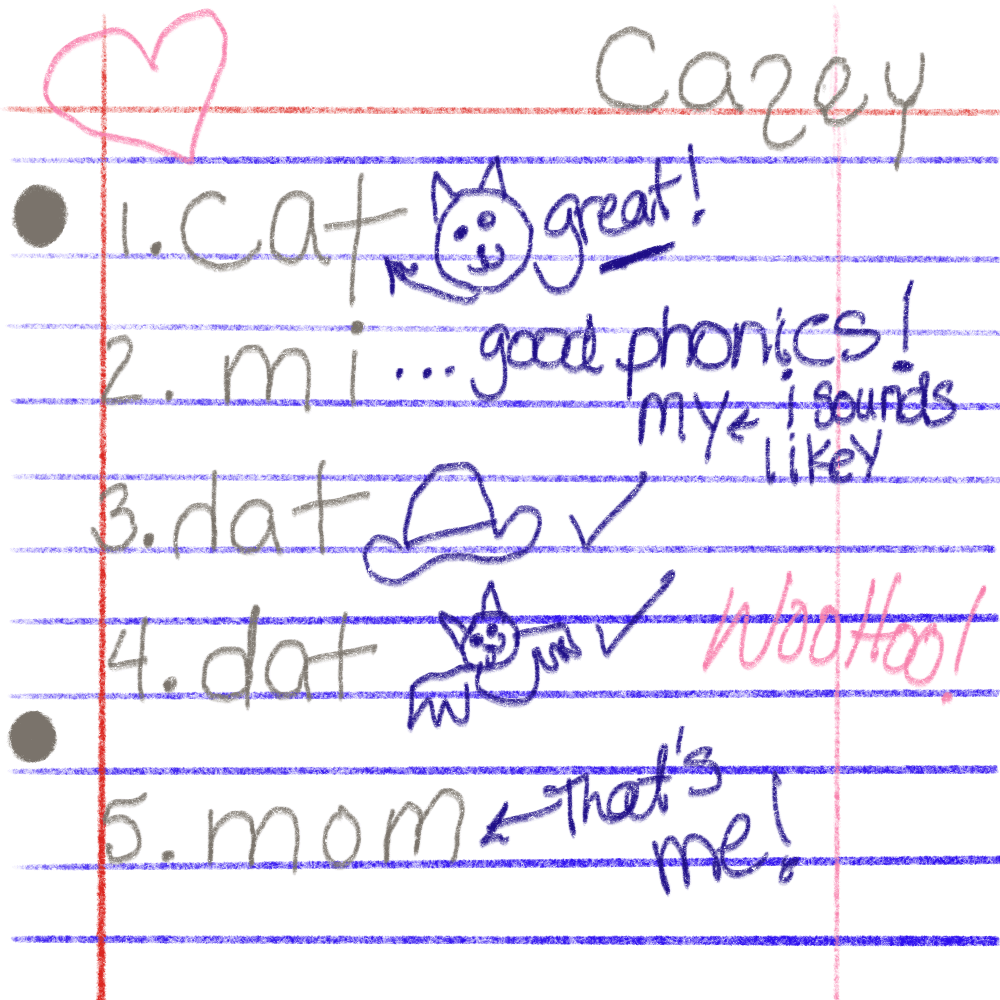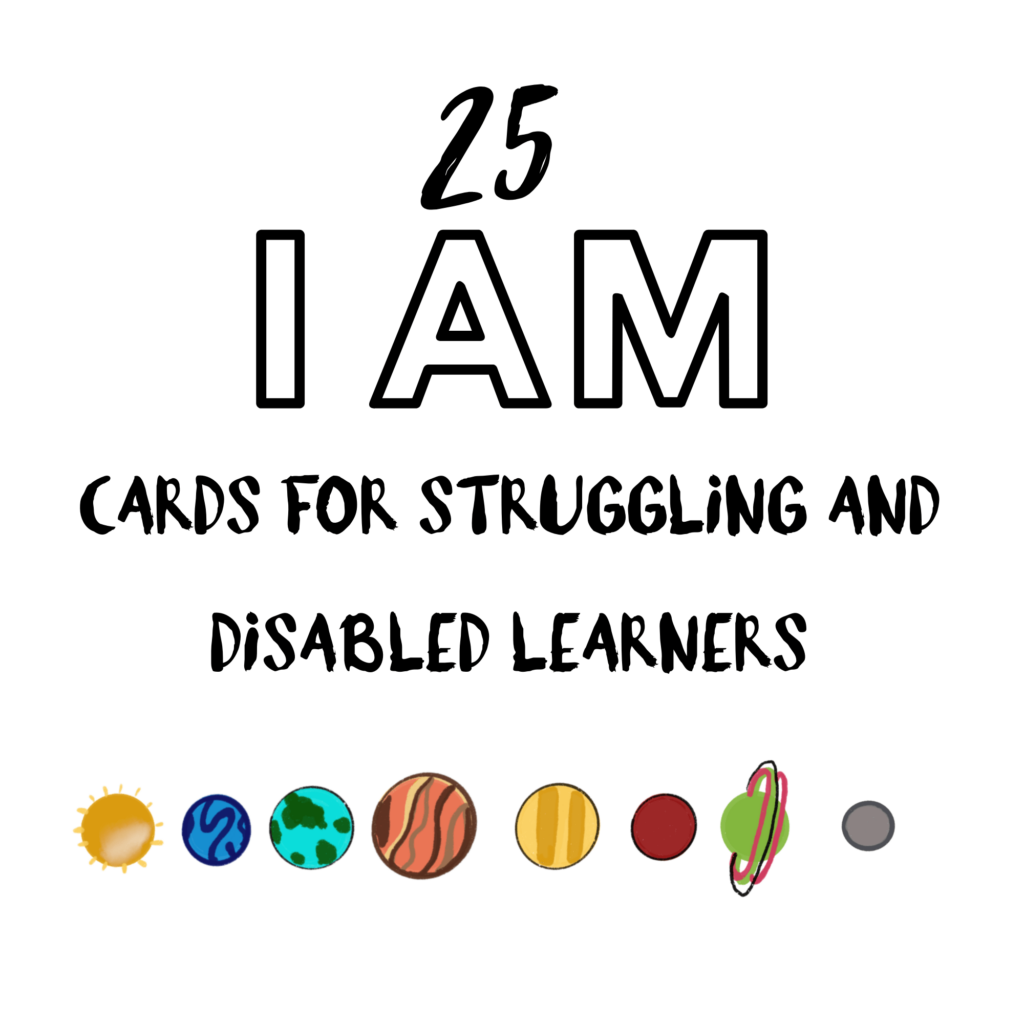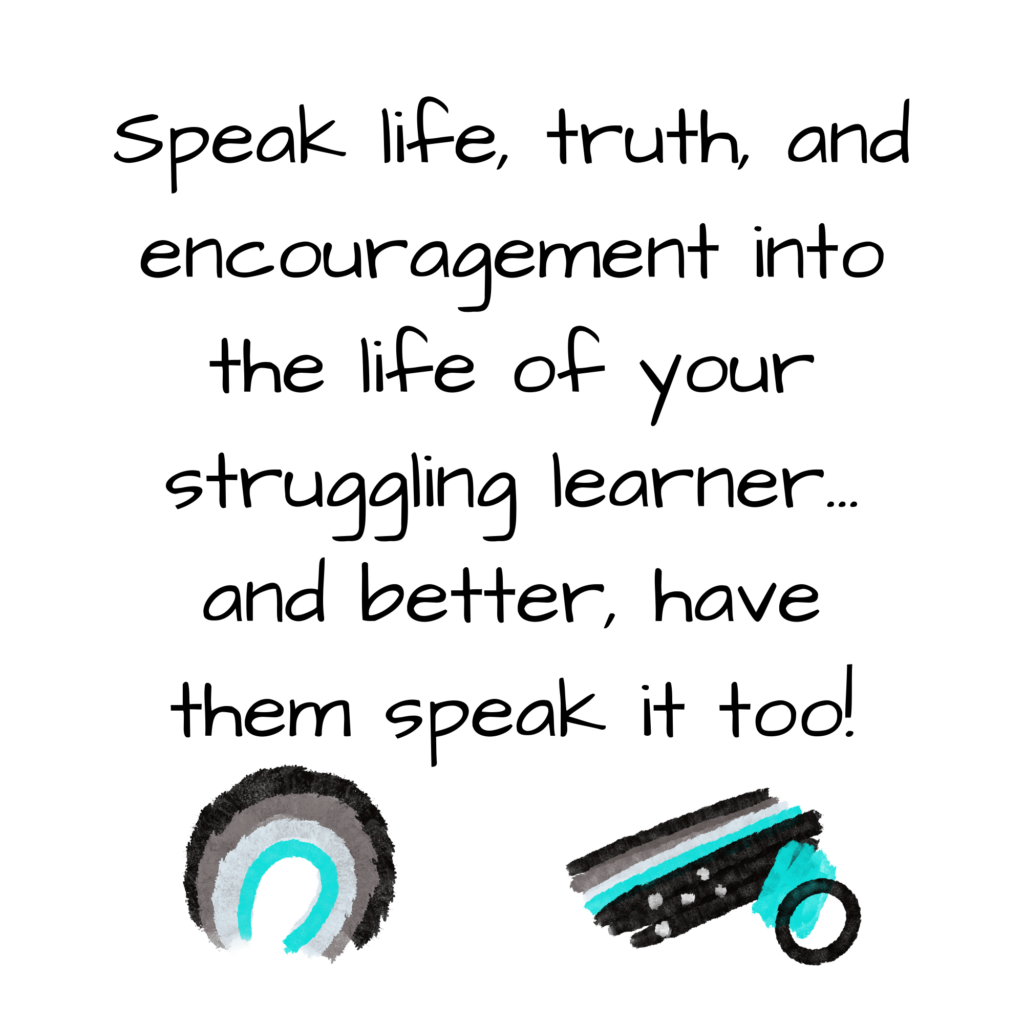
Homeschooling A Disabled Learner: Ten Things to Consider
Homeschooling A Disabled Learner: Ten Things to Consider
Welcome back, this is post #5 in the Help! My Kid has Learning Disabilities summer series. And today I have TEN things to consider when homeschooling a disabled learner. Here is the countdown!
I loved homeschooling. I have said this, I know. But, here I go again, we have run the gamut of schooling. 3 graduated from home, 1 is graduating in the fall from public high school, and two have their little education landscape ahead of them. Charlie and Sam, our two young adopted sons are 5 and 7. And making decisions about educating them, well things are different than they were 19 years ago. That first time we sat down to homeschool, I had no idea what was ahead of me…
But now, well, at least here are a few things I know that might help you with homeschooling a disabled learner…
-
Relax.
Oh my gosh, this is the BEST part of homeschooling, especially when it comes to homeschool and the delayed or disabled learner. If I had it to do all over again, this would have been my chant.
Relax!
If you are homeschooling a learner that doesn’t jive to scholastic and societal “norms” do not try and keep up with those norms at home!
Yes, a school day in public lasts from 8:00 to 3:00, because it HAS TO! If 20 kids have to go potty and each one needs 10 minutes of one on one teacher time, and the line at lunch has 500 students in it, the students and teachers need a full day to get everything done.
You do not have to do school for 7 hours straight to have a successful school day.
And, I would suggest, that is probably the last thing your LD child needs either. That is the beauty of homeschooling, time to get to what needs to get done and plenty of time to play outside, bake a cake, or just be.
You can only try and fill seven hours of a homeschool day with homeschooling if you are making your children wait in line to go to the bathroom. When homeschool was the most un-effective for me and my kids, it was when I was stressed about keeping up with the world outside my window.
This is ironic because I would have told you we came home to reduce stress.
When I added back the world’s standards to the home standard of learning, I only added to the load. So yes, relax. Kick back and be an example of chill to your children by teaching from a place of, “yes, and we will get to that… and if we don’t, there will be other opportunities.”
Granted, I live in Texas, God bless this state and its love of homeschool. But even if you live in a state where the homeschool laws are stiffer than the gross socks you just found under the couch, there are ways to add some chill back to the routine. (I have two more posts coming with more about atmosphere and organization so make sure to subscribe or follow me on the Socials so you don’t miss those!)
But I said it before, and I will say it as many times as I have to, if your child is struggling to grasp concepts, the greatest way to cause stress and strife is to punish a child for something they simply cannot do.
Again, it is like putting a 5-month-old in time out for pooping in their diaper.
Patience… I know. It seems logical when someone fails to have consequences. But I am of the belief, the struggle an LD child faces is the consequence. Adding a punishment to the routine sets them and you up for defeat.
-
Let them teach
Yeah, this was one of my most favorite ways to motivate and engrain things in my LD children’s sweet noggins. If they have younger siblings it is great, if they don’t well… here is one of my most fun resources:
Recording themselves teaching.
Let’s use phonics as an example and we will use the letter P. We had a large dry erase board and markers all the colors of the rainbow, but you can use poster board, a chalkboard, or even get some regular printer paper, crayons, and tape. The child finds 5-10 household items that start with the letter P. They decorate the space (or chalk/dry erase board) for teaching the letter P. And then, you set up a camcorder, iPhone, or computer to record them teaching you or someone else about the letter P.
Teaching manifests knowledge. And it gives your child creative power to make the concept of P, concrete.
Older children? While you may have to show them how at first, have them create a powerpoint with their favorite colors, concepts, and music, What better way could you actually learn a hard concept than by creating all of the aspects into something that will stay in their minds as visual? I am including a video on iMovie as another idea for teaching content. If your child suffers from a processing disorder, one of the best ways to learn is to focus on how the child does process. In the of making the movie, they are interacting with the concept. So have them create visual projects for concepts. And while it may seem like another thing you have to teach your child, iMovie and PowerPoint are easy to use, which I can prove, because even I can do it. Here is an example:
I will interject, if you use this method, make sure you have an excellent internet filter and then get familiar with free web image sites like Unsplash and Pexels. As an added bonus, they are meeting some of the high school tech credits, two birds, one stone.
In our case, John had an auditory processing disorder. For many years we thought he was actually deaf. But once we learned he processed by sight and experience we were able to better accommodate and teach him. Furthermore, the things he does remember and is an expert at are the things that he physically participated in. Which brings me to number 3…
-
Get out of here
Homeschooling doesn’t have to be at home. Experiences are one of the prime reasons we loved homeschooling. Some of the best homeschool days we had we in the backyard, at the library, or in the parking lot of Schlotsky’s or homeschool track practice. And! On those excursions, you can bet, the stereo was alive with playlists that counted, multiplied, chanted, and reviewed all the things I needed in my children’s head.
Yes, I can name the periodic table. And yes, I have to sing it to a cover song from the High School musical soundtrack.
This among several other weird homeschool accomplishment should be listed in my obituary, please, and thank you.
Letting my children function out in the world is how I loved to teach them. From counting out the money to pay for groceries, to a lively scavenger hunt at the zoo, to a day of schooling at the coffee shop, we sought experiences and embraced the freedom that homeschooling alone, afforded us.
-
Get a buddy
Homeschooling is hard. And homeschooling a learner that struggles is by far, the hardest thing I ever did. But man, I made some great friends.
Friends that knew and understand my walk were entirely priceless. For a long season I hosted “Thurstudy” at my house. 6 Families chipped in food and delivered their kids to the ranch. Some of the moms would stay and drink coffee and help the kids with assignments, others took the opportunity to get their blood work done or roots tended to. The kids did school work together, climbed trees, listened to music, and memorized Latin derivatives.
And, of those kids, 80% of them are still our close friends. As a matter fact, our son John recently married one of the girls that frequented our home for Thurstudy.
While this was a pretty big undertaking, there are other ways to do it too.
We knew other families that rotated with each other. And there are COOPS and University Model homeschool programs that provide children with a day out. But, I am talking more about you. You need someone, a good friend, sister, or neighbor that homeschools too.
They certainly don’t have to be your only outlet, but they will be chief in your sanity.
Above all, a homeschooling community is where you will find moms with struggling learners too.
And those are your people. I remember once a homeschool mom was telling me how to teach John to read. They were dear suggestions, but all I could hear was my heart pounding in my head and feel the lump rising in my throat. When she walked away, another mom wrapped her arm around my shoulder and said, “Great tips, unless they still haven’t mastered the alphabet, huh, friend?”
Yeah. Homeschool moms UNTIE!
See what I did there?
-
Toss the grade book
You most definitely need to keep good records. You will need them in the event you graduate your child from home or you eventually need to send your children to school. And, not to be morbid, but in the event something happens that prevents you from homeschooling or untimely death, keep your records. However, we didn’t put grades on everything our children did, especially our LD learners.
Success breeds success. But if you have constant failure in red markings in your face, it is much easier to focus on failures.
A One-Minute Manager system for showing your LD child the results of their work is a fantastic model for encouraging and correcting. I am including an example of what it looks like to grade a paper using overwhelming positivity over “grading.”
And, using this language helps build up confidence. Actively highlighting what is right, especially when a child is primed to hear all that is wrong, stabilizes their mood.

Grading a paper can be a list of what was right, not just what was wrong
Another example:
Mom: You missed 19 of the 20 problems on this assignment.
VS.
Mom: You completed every single one of these problems. I am so proud of you. Your handwriting was very neat and I can tell you tried very hard. Now, some of the problems were wrong, so we are going to do it again. This time, I want you to use these grapes as a counter. And if you want, I will sit with you while you work. You are such a hard worker.
Building up your child’s abilities instead of diving into their failures is a great reason to homeschool.
We used this model which such tenacity, the kids started using it on us.
One time when I picked our son Luke up from swim team and handed him his breakfast, he said, “Mom, this is an excellent breakfast. You are doing a great job. You know, what would be nice is a little less cheese on my breakfast burrito. I couldn’t be happier than having you for a mother.”
Hmmmm.
Furthermore, if you are using a workbook based curriculum, I recommend making copies of the work for multiple opportunities to try again, so as not to focus on the daunting record of failures. Even if you staple corrected or improved work into the work book, you are actively keeping the atmosphere one of successes. (Note: making copies of curriculum is only okay if you own the curriculum and are not reproducing it for profit or sharing… I know you know this, but I have to say it.)
-
Be Flexibly Consistent with Curriculum
One of the hardest parts of homeschooling for me was… curriculum hopping. Well, that and shopping. I was quick to hit the stores and internet trying to find something, anything that would improve my children’s understanding of a concept.
4
Believe me, I know it is easy to get frustrated and go try something new. And if something is not working and there is a new methodology you want to implement, I am not saying not to. But, sometimes, the curriculum contains all you need, you just might have to implement other means of conveying the information.
For example, I jumped ship on Saxon math like a crazy women jumping from a burning building, repeatedly.
When I just could not take it anymore, we invested in Math-U-See (MUS.) Now, hear me out, I am not actively criticizing either of these curriculums (well, kind of I am, Saxon, you wicked wonderful beast,) however, MUS, was not for me and it was overWwhelming to my already struggling children.
When push came to shove, Saxon Math was consistent, it laid out exactly what I needed to teach, built on the previous concept… and darn it, was just a better program for me to teach. To this day, it is the bane of my existence.
Having said that, it wasn’t the curriculum as much as it was the teacher. If the end goal is math, then a program that is teacher and student friendly is imperative. This is the same reason I will forever be a fan of Shirley Grammar. I needed to know what to teach and when, and I loved building on what we had already experienced. (Not to mention the fact I finally fully understood what an adverb was… who knew?)
When it came right down to it, we had done Saxon for so long, albeit through gritted teeth, reinventing how we did math with MUS was harder than the original equation. So, with tons of beautiful counting blocks, we used MUS manipulatives to enhance the Saxon model. But we stuck with Saxon, until we all required counseling and graduated.
While that doesn’t sound like a raving review for consistency, it absolutely paid off as the children advanced and the younger ones came up in the ranks.
If you are blessed with a community, invest in time researching curriculums that have worked for other families and then ASK TO SEE IT IN PRACTICE. Before you spend a dime, check it out for yourself and your children. Trust me, it is as good as money in the bank to see, touch, taste, and smell curriculum in practice. Also, don’t lick your friend’s curriculum, I was only trying to make a point.
-
Move it
Of the cycles of defeat we met with, one was the desk. There is this looming thought process, seated is better. Again I say to you, you are home, be home. If your child learns better standing, that is not a hill to die on. Let them stand.
Take frequent breaks from monotony. Finish a spelling list, go for a walk or let them jump on the trampoline. By inserting physical movement and a change of scenery, you are helping your child get oxygen to their hardworking brains, and you can finally go to the bathroom.
I will be talking about juggling for focus and other methods for reading and creating for learning in another post.
And, if your child is easily distracted, choose spaces free from distractions. If your 8-year-old boy is obsessed with screens, avoid teaching in a room with a screen. My nephew, who was enrolled in public school for three years, had a report sent home stating that he would not pay attention in class. My sister went to watch and see what the problem was. It was a pretty easy fix, his desk was two feet from the computer center. The class would rotate from stations, but his mind never vacated the computer center. Once he was moved to the other side of the classroom, he was operating at full capacity.
Out of sight, out of mind.
In the same way, if your child is sensitive to smell, they may not be able to concentrate in the dining room or next to the diaper genie. If sound overwhelms them, try headphones, or create a quiet space for them to work. Sensory issues are much easier to control in the home than they are in a class of 25 children, (if you have 25 children, you may need another blog post.) If suddenly you find your child distracted, take an inventory of the surroundings and be flexible about where you are instructing them. Again, I am linking another post about creating a great atmosphere for schooling.
-
Structure
Okay, a lot of what I have been saying may seem like an absence of structure. On the contrary, what I am saying is that your homeschool structure can be modeled to fit what works for your learner. And you can call me nuts, it won’t be the first time, but my little homeschool even had uniforms.
Yup.
While we had one kid doing phonics while he stood in a chair, and another who played the guitar while he worked, every day but Friday they were showered, hair fixed, and wearing a “Bread of Life Academy shirt.” Originally, that uniform also included shoes, but friend, pick your battles. Luke mastered Chemistry barefoot.
The uniforms were just cheap collared golf shirts from Walmart. I had our logo embroidered on the breast. And we handed them down to the next kid for years. And while this might sound expensive, it was something that brought order to the home classroom. It set the tone for what we were going to accomplish that day. The children knew that come Friday they could work in their pajamas, but homeschool didn’t mean we were not members of a clothed society.
A friend of mine who also used uniforms, simply ordered t-shirts with their school logo on the front. Each child had four t-shirts, a different color for each day of the week. Still another family we knew used plain t-shirts, no logo, but they represented their “work” clothes.
I want to interject here, my LD learners were time hounds. I used this to my benefit. It is time to do this subject and then it will be time to go outside. Having a set schedule for learning versus play can really help a LD child stay in the moment, knowing that there is something else coming. You can have a structured schedule that keeps everyone in the know and still not be a slave to the schedule.
And this was also helpful. When we were homeschooling and had foster placements, a random home inspection might throw off my school day. But having a schedule without being legalistic afforded me and my kids peace of mind.
Structure doesn’t have to mean that everyone sits at miniature desks in the spare bedroom. Structure that fits where and when your child learns is one of the blessings of homeschooling.
When my kids entered adolescence and required more sleep, I would not have them start their studies until 10:00. They could sleep until 8 or 9 as long as they were dressed, fed, and ready to start by 10. Later, when they were older and able to work independently, I still required they be dressed and ready, but they were able to do their assignments in their room or in the recliner in the study, as long as I was able to check it and they were diligent with the day’s requirements.
-
Make Learning Fun and of Benefit
You are home with your child, enjoy it. We taught number placement with gummy bears and ladybugs. And we taught measurement with a cooking unit. But the feather in my cap, we learned anatomy in a morgue. Yep, all dissections and biology lessons were done in the back of a tiny funeral home in my husband’s hometown.
And, at least in Texas, we were able to apply real life experiences into our school credits. John and Luke both learned to plow and seed at our ranch, instant Agriculture elective credit.
When we got our foster license we all took CPR and First Aid. There is your homeschooling health credit.
P.E. doesn’t have to be the ability to climb a rope or dodge a ball. I taught yoga, so my kids went to yoga. Sophie loved to dance. So her dance classes were her P.E. credit.
The fact is, we learn from doing.
And we learn even more when we love what we are doing. John struggled to learn to read. But given a chance to visit a war museum he would remember every single display and factoid that was thrown his way. He was a visual learner, so videos and the history channel were the thing he looked most forward to. And Luke? Luke wanted to be a doctor (yeah, he changed his mind) so he shadowed two doctor friends, on one occasion for an eye surgery!
We got dirty, dug for worms, grew mold, and harvested butterflies. Then we painted spelling words on an old brick wall with spray paint, and we counted those as great works of art! Shazam! Two for one!
Homeschooling afforded us the joys of learning in new and fun ways, ones that were not always available in a classroom.
And, there are so many more opportunities now then there were even a couple of years ago. Try supplementing your child’s day with their passion. I love the courses offered by “A Beautiful Mess.” If your child loves to write or take photographs, taking classes where they are not “graded” so much as they are able to study and implement what they are learning into an activity they love, talk about progress!
One of my kids who LOVED to write fantasy fiction would do a regular English assignment and as soon as he was finished with that he could write. We added Grammarly to our computer, which is of great help to me too, and he would hammer out stories and then Grammarly would highlight mistakes.
Going back through the corrections himself, he would see spelling and grammatical errors, and every time he fixed them, he grew to be a better writer. In my opinion, this type of constructive correction, where the child can see the mistake and remedy it is an enormously beneficial method of instruction.
-
Know when it is time to hold’em, and know when to fold em.
Ugh. Now we will all have that Kenny Rogers’ ditty in our heads all day. But it is true, sometimes something works and sometimes it does not. Friend, I have a book out for acquisition on all things for me and not for me. Homeschooling is absolutely wonderful, until it is not. What I didn’t know back then was, I was wholly and entirely loved for being just me. The classification of beloved daughter doesn’t not change if we teach Algebra at the kitchen table or if we send our babies to the worst public school in the country.
Grace is the final word. Give it to yourself, and give it to your neighbor.
If homeschooling is absolutely your jam and entirely working for your family, you go girl. If it is not, if you just can’t anymore, or every aspect of your life has changed, is changing, or stays the same, and it is just time, you have not failed the God who calls you blessed.
Of the saddest days in my parenting and homeschool journey, it was the day that Justin took John to his first day at a school for children with learning disabilities. I had worked so hard. And I loved the freedom that came with homeschooling, but John was stuck in a rut that I could not get him out of.
I cried all day. And while John would later return home and graduate from home, there was a season where he had to have more help than I was able to offer him.
All this to say, oh how I love homeschooling.
This calling, the vocation of motherhood with the blessing of educating your humans is a mixed bag. There is no one size fits all model. At the end of this post, the very best advice is to do you. Do what blesses and encourages your child. Toss out what society says has to be done NOW for what your heart says is great teaching. A safe home, where your child can explore what works and what does not, without shame or inadequacies, is the best classroom seat on the planet!
Stay tuned for MORE!!!
And get caught up!
- Help my kid has learning disabilities
- Shaping the mind of the LD child
- Social Helps for the LD child
- The LD Child and Teachers
Until then, May your floors be sticky and your calling ordained! Love, Jami
Get your I am Cards for Struggling Learners here now! Speak life and truth into your baby!
Get your I am Cards for Struggling Learners here now! Speak life and truth into your baby!
I have made this set of “I am cards” from journal entries I had when John was just a boy. I am in awe of the work that God had before John and I even realized it was to be. Things no eye had seen. literally no ear had heard. I know that you might be scared with all that is before you with a struggling learner. So, I pray these cards offer you hope in the future God has planned for you and your child.
I recommend printing these on card stock and cutting them in half.
Get them here!










Yes, yes, yes
Sometimes I wonder if homeschooling my youngest is so easy because he’s easy or if it’s just because I finally learned to relax. That being said I was up late last night researching 11th grade English for my dyslexic daughter. Mom guilt is very real thing.
[…] But for many years I was the mom of a delayed learner. […]